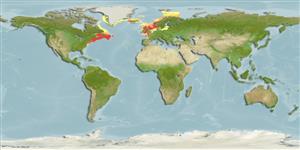Classification / Names
Common names from other countries
Main reference
आकार / वज़न / Age
Max length : 130 cm TL पुल्लिंग / अलिंग; (Ref. 1371); common length : 60.0 cm TL पुल्लिंग / अलिंग; (Ref. 4645); अधिकतम प्रकाशित वज़न: 32.0 kg (Ref. 7251); अधिकतम सूचित उम्र: 25 वर्षो (Ref. 1371)
Length at first maturity
Lm 39.1 range ? - ? cm
पर्यावरण
; समुद्री ड़िमरसल; औशिनोड़िरोमस (Ref. 51243); गहराई सीमा 37 - 364 m (Ref. 5951)
जलवायु / सीमा
Temperate, preferred 6°C (Ref. 107945); 77°N - 33°N, 76°W - 35°E
वितरण
Eastern Atlantic: Barents Sea, Spitsbergen to Bay of Biscay, around Iceland. Western Atlantic: southwest Greenland, Hudson Strait to North Carolina, although rare at the extremes of the range. Migrations for spawning are known to occur. Also long-distance north-south migrations for Europe and the US.
देश | ऐफ ऐ ओ क्षेत्र | Ecosystems | संयोग | भूमिका
Short description
पृष्ठीय रीढ़ (सम्पूर्ण): 0; गुदा कांटा 0. Chin barbel small. Lateral line smooth along its entire length. Body color is brownish-green dorsally, becoming only slightly paler ventrally. The lateral line pale.
IUCN Red List Status (Ref. 115185)
Threat to humans
Harmless
Human uses
मात्स्यिकी: उच्च वाणिज्य; आखेट मत्स्य: हां
साधन
Special reports
Download XML
इंटरनेट स्रोत
Estimates of some properties based on models
Phylogenetic diversity index
PD50 = 0.7500 many relatives (e.g. carps) 0.5 - 2.0 few relatives (e.g. lungfishes)
Trophic Level
4.3 ±0.4 se; Based on diet studies.
लौटाव
माध्यम, न्यूनतम जनसंख्या दुगनी होने का समय 1.4 - 4.4 वर्ष। (rm=0.55-0.87; K=0.07-0.17; tm=2-10; tmax=25; Fec=220,000)
Vulnerability
High vulnerability (59 of 100)
Price category
